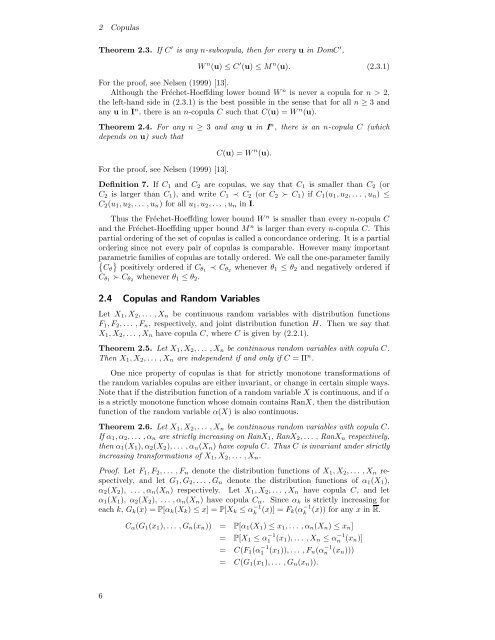Modelling Dependence with Copulas - IFOR
Modelling Dependence with Copulas - IFOR
Modelling Dependence with Copulas - IFOR
You also want an ePaper? Increase the reach of your titles
YUMPU automatically turns print PDFs into web optimized ePapers that Google loves.
2 <strong>Copulas</strong><br />
Theorem 2.3. If C ′ is any n-subcopula, then for every u in DomC ′ ,<br />
W n (u) ≤ C ′ (u) ≤ M n (u). (2.3.1)<br />
For the proof, see Nelsen (1999) [13].<br />
Although the Fréchet-Hoeffding lower bound W n is never a copula for n>2,<br />
the left-hand side in (2.3.1) is the best possible in the sense that for all n ≥ 3and<br />
any u in I n , there is an n-copula C such that C(u) =W n (u).<br />
Theorem 2.4. For any n ≥ 3 and any u in I n , there is an n-copula C (which<br />
depends on u) such that<br />
For the proof, see Nelsen (1999) [13].<br />
C(u) =W n (u).<br />
Definition 7. If C 1 and C 2 are copulas, we say that C 1 is smaller than C 2 (or<br />
C 2 is larger than C 1 ), and write C 1 ≺ C 2 (or C 2 ≻ C 1 )ifC 1 (u 1 ,u 2 ,... ,u n ) ≤<br />
C 2 (u 1 ,u 2 ,... ,u n ) for all u 1 ,u 2 ,... ,u n in I.<br />
Thus the Fréchet-Hoeffding lower bound W n is smaller than every n-copula C<br />
and the Fréchet-Hoeffding upper bound M n is larger than every n-copula C. This<br />
partial ordering of the set of copulas is called a concordance ordering. It is a partial<br />
ordering since not every pair of copulas is comparable. However many important<br />
parametric families of copulas are totally ordered. We call the one-parameter family<br />
{<br />
Cθ<br />
}<br />
positively ordered if Cθ1 ≺ C θ2 whenever θ 1 ≤ θ 2 and negatively ordered if<br />
C θ1 ≻ C θ2 whenever θ 1 ≤ θ 2 .<br />
2.4 <strong>Copulas</strong> and Random Variables<br />
Let X 1 ,X 2 ,... ,X n be continuous random variables <strong>with</strong> distribution functions<br />
F 1 ,F 2 ,... ,F n , respectively, and joint distribution function H. Then we say that<br />
X 1 ,X 2 ,... ,X n have copula C, whereC is given by (2.2.1).<br />
Theorem 2.5. Let X 1 ,X 2 ,... ,X n be continuous random variables <strong>with</strong> copula C.<br />
Then X 1 ,X 2 ,... ,X n are independent if and only if C =Π n .<br />
One nice property of copulas is that for strictly monotone transformations of<br />
the random variables copulas are either invariant, or change in certain simple ways.<br />
Note that if the distribution function of a random variable X is continuous, and if α<br />
is a strictly monotone function whose domain contains RanX, then the distribution<br />
function of the random variable α(X) is also continuous.<br />
Theorem 2.6. Let X 1 ,X 2 ,... ,X n be continuous random variables <strong>with</strong> copula C.<br />
If α 1 ,α 2 ,... ,α n are strictly increasing on RanX 1 , RanX 2 ,... ,RanX n respectively,<br />
then α 1 (X 1 ),α 2 (X 2 ),... ,α n (X n ) have copula C. Thus C is invariant under strictly<br />
increasing transformations of X 1 ,X 2 ,... ,X n .<br />
Proof. Let F 1 ,F 2 ,... ,F n denote the distribution functions of X 1 ,X 2 ,... ,X n respectively,<br />
and let G 1 ,G 2 ,... ,G n denote the distribution functions of α 1 (X 1 ),<br />
α 2 (X 2 ), ... ,α n (X n ) respectively. Let X 1 ,X 2 ,... ,X n have copula C, and let<br />
α 1 (X 1 ), α 2 (X 2 ), ... ,α n (X n ) have copula C α . Since α k is strictly increasing for<br />
each k, G k (x) =P[α k (X k ) ≤ x] =P[X k ≤ α −1<br />
k<br />
(x)] = F k(α −1<br />
k<br />
(x)) for any x in R.<br />
C α (G 1 (x 1 ),... ,G n (x n )) = P[α 1 (X 1 ) ≤ x 1 ,... ,α n (X n ) ≤ x n ]<br />
= P[X 1 ≤ α −1<br />
1 (x 1),... ,X n ≤ α −1<br />
n (x n)]<br />
= C(F 1 (α −1<br />
1 (x 1)),... ,F n (α −1<br />
n (x n )))<br />
= C(G 1 (x 1 ),... ,G n (x n )).<br />
6
















